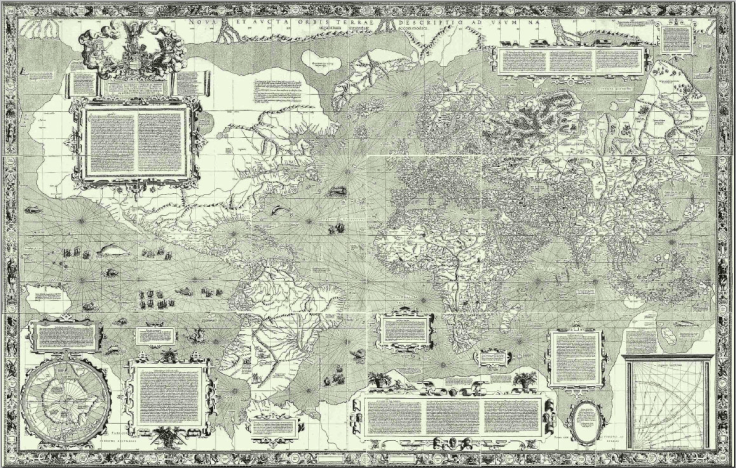Mercator And Mice: How Spatially Resolved Genomic Analysis Is Changing How We Study The Building Blocks Of Life
Sailors plying the world’s oceans today owe Gerardus Mercator a debt of gratitude. Born in Rupelmonde in the Holy Roman Empire in 1512, Mercator was a polymath best known for his contributions to cartography – the discipline of map-making.

In the era Mercator was working, sailors were typically unable to navigate between two points on the globe without conducting complex (and potentially erroneous) calculations. Mercator’s projection did away with this, allowing sailors to follow a straight line between two points on a map with only a compass to assist them. In reality, these lines were not the shortest routes (the further one sailed the more the lines bent) but the map provided a reliable way to travel across the world’s oceans and became the basis of nearly every Western nautical map in the centuries that followed.
The impact of Mercator’s work was seismic, opening the world up to explorers and traders, accelerating the European Age of Discovery and later the Age of Sail, and ushering in our globalised world. Now, a similarly dramatic change is taking place in the field of genomics.
Spatially resolved analysis of gene expression – in short, simultaneously knowing where cells are within an organism and analysing their genetic origins – is nothing short of a revolution in imaging and genomic analysis. Called Stereo-seq (SpaTial Enhanced Resolution Omics-sequencing), the technology has been developed by BGI Group, the Shenzen-based genomics company. The technology relies on patented DNA nanoball technology, which amplifies small fragments of DNA into larger samples. This technique was combined with in-situ RNA capture technology to achieve a visual resolution of 500 nanometers (equivalent to 0.0000005 meter) with a very wide field of view.
Until recently, researchers who wished to analyse the genetic makeup of an organism have been limited to methods which provided a macro-level overview of the subject’s genetic code. This approach has been compared to making a smoothie, offering broad-based findings, but lacking in specificity.
Stereo-seq technology allows for truly ground-breaking analysis of cellular processes, offering the highest-resolution spatial transcriptomic detection in the world. If conventional approaches to genomic analysis are like making a smoothie, Stereo-seq is more like a fruit bowl – each constituent part of a sample can be analysed in its proper place.
A paper featured on the cover of the current issue of Cell Magazine demonstrated the potential of the technology to break new ground. The study into mouse organogenesis (the embryonic development of the mammal’s organs) saw scientists create the highest resolution transcriptomic ‘atlas' of a mouse’s development ever achieved. Genomics is the study of genes, how DNA carries all of the instructions needed to produce proteins (the building blocks of life). DNA goes on to create RNA, which then carries out the instructions coded in the DNA. A ‘transcriptome’ functions in much the same way as a map, indicating how and where the DNA instructions are carried out.
Just like Mercator’s projection, the below image represents a dramatic departure – offering a new way to observe the development of an organism in the form of a cellular ‘map’ of each cell in the organism, how they relate to each other and, crucially, how each cell corresponds to a part of the transcriptome, the organism’s individual RNA, and ultimately it’s DNA.
This image, which featured on the cover of Cell in May, shows a mouse embryo at 16.5 days of gestation. Mice typically gestate for between 19 and 21 days, meaning this image offers remarkable and ground-breaking insight into the animal’s development close to the point at which it is fully developed.
The advances made by BGI can be compared with the launch of the James Webb Telescope in terms of their impact on our understanding of the universe. In fact, conceptually, the telescope and Stereo-seq have more in common than may be obvious at a first glance. The James Webb Telescope promises to expand our understanding of some of the furthest objects from Earth, gazing outward into history to view the first suns and galaxies that came into existence after the big-bang; Stereo-seq allows researchers to gaze inwards, giving us insight into the minute processes that maintain life on Earth.
The potential impact of the technology cannot be understated; just as the James Webb Telescope promises to teach us about the origins and construction of the universe, Stereo-seq promises to teach us about the origins and construction of life. Its applications in the study of cancer, inherited disease, and even organ regeneration are extensive.
Cancer treatment offers a particularly strong use-case for Stereo-seq. Analysis of a patient’s genetic material, before and after a drug is prescribed, could lead to more targeted care and vastly improved care outcomes – a significant challenge with currently available technology. Tailor-made drugs, which are developed in concert with analysis of an individual’s genome could further uplift our ability to challenge and overcome our most pressing healthcare challenges.
It's interesting to consider what Mercator would think of the modern world. Which of our advances would impress him most? Spaceflight, particle acceleration? We now have the ability to observe events so microscopic and short-lived that it might be said they never happened at all. It is of course impossible to say for sure. But it has to be admitted that the advances being made in the field of genomics, particularly since the completion of the Human Genome Project in 2003, are among the most exciting of the modern era.
The tools we have at our fingertips are increasingly allowing us to uncover the mysteries of life. Like Mercator’s map and the James Webb telescope, technology such as Stereo-seq is revealing a path into the future.





















